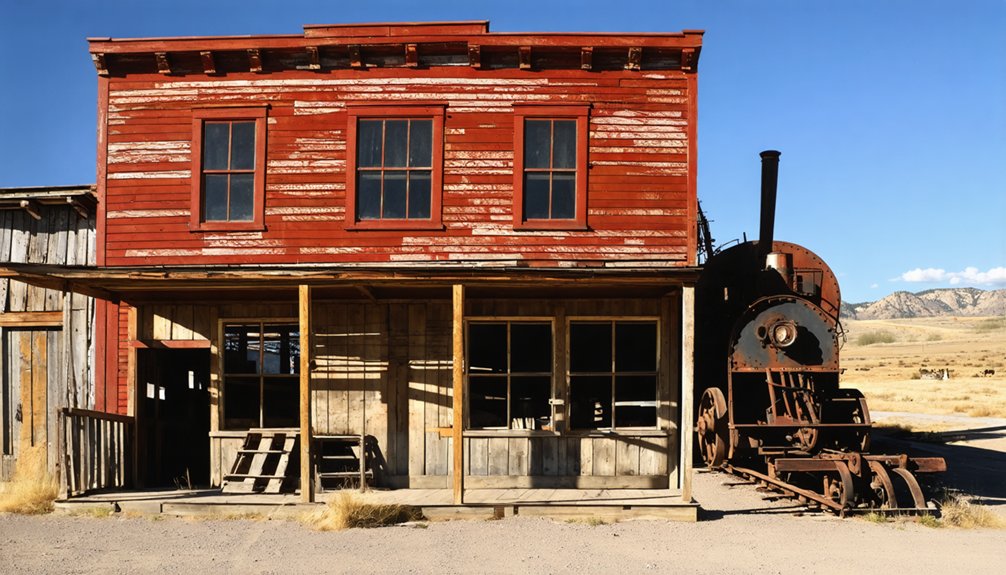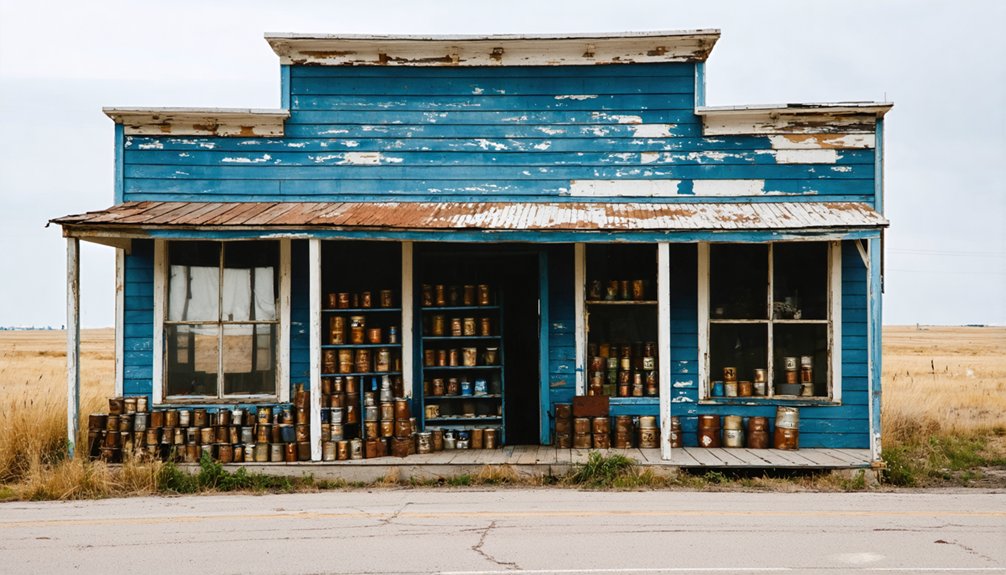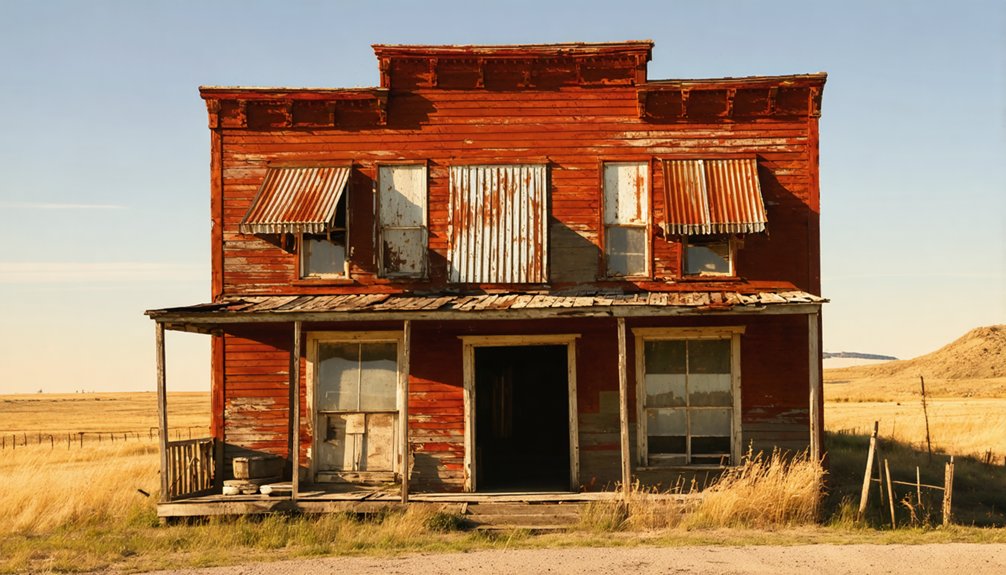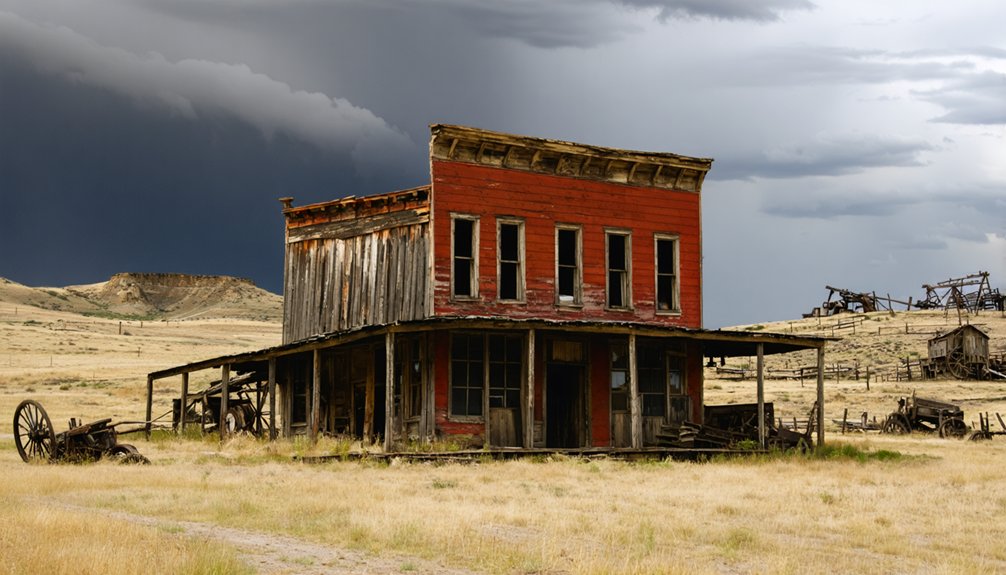You’ll find Placerville nestled in South Dakota’s Black Hills, where gold’s discovery in 1874 sparked a mining boomtown that violated the Fort Laramie Treaty with the Sioux Nation. The settlement quickly grew to include general stores, boarding houses, and a post office by 1879. While hydraulic mining and stamp mills drove its early success, the town couldn’t survive the industry’s decline in the early 1900s. Today, its preserved ruins tell a compelling story of America’s mining frontier.
Key Takeaways
- Placerville emerged as a mining settlement during the Black Hills Gold Rush of 1874, following Custer’s expedition and violation of the Fort Laramie Treaty.
- The town thrived with general stores, boarding houses, and mining operations, receiving its first post office in 1879.
- Mining techniques evolved from basic panning to advanced hydraulic methods, with stamp mills processing ore from local gold deposits.
- Transportation infrastructure, including railroad connections near Elrod, initially supported the town’s growth but later contributed to its isolation.
- Placerville became a ghost town in the early 1900s due to mining industry decline, mine consolidations, and the loss of essential services.
The Black Hills Gold Rush Origins
While the Black Hills had long been sacred to the Lakota Sioux, everything changed in 1874 when Lieutenant Colonel George Armstrong Custer’s expedition discovered gold in French Creek near present-day Custer, South Dakota.
You’ll find that the Custer Expedition, though initially tasked with mapping the region, sparked one of America’s most significant gold rushes. Their discovery violated the Fort Laramie Treaty of 1868, which had guaranteed these lands to the Sioux people. This violation ultimately led to increased conflicts known as the Indian Wars between settlers and Native Americans. The tensions escalated when Sioux leaders refused to sell the Black Hills during negotiations in Washington, D.C. in 1875.
Within months, thousands of prospectors flooded the area, defying the Sioux Treaty and establishing bustling boomtowns like Deadwood. The rush transformed the Black Hills from a pristine wilderness into a mining frontier, where prospectors sought their fortunes in the rugged gulches and valleys that had once been undisturbed Native American territory.
Mining Operations and Technology
While miners in Placerville used common Black Hills techniques like crushing and mercury amalgamation to extract gold from ore, you’ll find that hydraulic mining became particularly significant in this region.
You can still spot remnants of the extensive water management systems they built, including ditches and flumes that carried water from higher elevations to power their hydraulic monitors.
The mining infrastructure expanded to include stamp mills for ore processing, which complemented the hydraulic operations and helped establish Placerville as a remarkable mining camp in the Black Hills. Similar to the Homestake mining operations, large stamp mills were crucial for processing the region’s abundant low-grade ore. The area saw its richest mining activity from the mid-1850s through the 1870s.
Hydraulic Mining Techniques Used
Powerful jets of high-pressure water transformed the landscape as hydraulic mining techniques revolutionized mineral extraction in the late 1800s.
While specific details about Placerville, South Dakota’s hydraulic mining operations remain limited, you’ll find that these operations typically employed hydraulic monitors – powerful nozzles that shot pressurized water to break down mineral-rich deposits. The technology, first developed in ancient Roman times, relied on redirecting water through pressurized systems.
Some operations may have used borehole extraction methods, drilling deep into the earth to access valuable resources. The innovative system used high pressure jets to fragment materials through 400mm boreholes driven from the surface.
- You can still see the dramatic scars left behind by these intensive mining methods, proof of humanity’s determination to harness nature’s power.
- The thunderous roar of water jets once echoed through these hills, as miners fought to reveal the earth’s treasures.
- Each mining site tells a story of innovation and grit, where independent spirits carved their destiny from raw earth.
Gold Extraction Methods
Gold extraction in Placerville relied on several key methods tailored to the unique mineral composition of the Black Hills region.
You’d find miners using pans and rockers to process placer deposits from stream beds, washing gravels to recover loose gold flakes.
When working with free milling ores, they’d crush the rock and use gravity concentration followed by mercury amalgamation for gold recovery.
As miners encountered more challenging refractory ores, they’d need advanced mining techniques like chlorination and smelting.
The pyretic process smelter in nearby Deadwood showed how the industry evolved to handle complex ores.
While mercury amalgamation proved effective for both placer and crushed ore processing, limited water availability often constrained operations, particularly in processing the rich placer deposits that first attracted prospectors to Placerville.
The hydraulic mining systems transformed the landscape as miners sought to extract gold from the extensive placer deposits.
Many of these mining operations were centered around the Homestake Mine discovery, which would go on to produce a significant portion of the world’s gold supply.
Mining Equipment and Infrastructure
As Placerville’s mining operations expanded beyond simple placer mining, you’d find an impressive array of industrial equipment transforming the landscape.
The advancement of mining technology brought stamp mills and gyratory crushers that could process ore more efficiently than ever before. Miners relied heavily on pneumatic drills to create holes for strategic blasting into the hard rock formations.
You’ll discover that by the 1880s, the town had evolved from simple placer operations to sophisticated hard rock mining, requiring extensive water management systems and deep shaft development.
- The thunderous rhythm of stamp mills crushing ore day and night, a sound that meant prosperity for freedom-seeking miners
- The intricate network of shafts descending hundreds of feet into the earth, representing mankind’s determination to chase fortune
- The constant flow of water pumps moving up to 600 gallons per minute, keeping the mines operational against all odds
Daily Life in Early Placerville
During the early settlement of Placerville, residents adapted their daily routines to the harsh realities of frontier life.
You’d find settlers living in sod houses, often partially dug into the ground for protection against brutal winters. Settlement patterns clustered near creeks, where families could access water and cultivate small gardens.
Your daily work would’ve revolved around farming, mining, and lumber production. You’d grow wheat and tend livestock while possibly working shifts at the Pacific Mine or local beech box factories. Local general stores dominated commerce, serving as essential hubs where settlers could obtain needed supplies.
Community events brought together the diverse mix of Dutch, Norwegian, and Danish settlers at churches and meeting halls. When you weren’t working, you’d preserve food through drying and smoking, ensuring survival through long winters.
The railroad served as your lifeline, connecting you to supplies, mail, and distant markets.
Economic Rise and Development

As Placerville’s mining operations expanded in the Black Hills, you’d have witnessed the rapid construction of infrastructure to support mineral extraction, including rudimentary mining shafts and basic ore processing facilities.
The town’s early business district emerged to serve the growing population of miners, with crucial establishments like general stores, boarding houses, and supply shops taking root along the main throughways.
Your daily commerce would have centered around these significant businesses, which formed the economic backbone of Placerville during its development phase.
Mining Operations and Infrastructure
While the initial gold discovery sparked intense interest in Placerville, the mining operations remained largely small-scale and primitive throughout the town’s brief existence.
You’d find prospectors using basic tools like rockers, pans, and sluices to separate gold from creek gravels, constantly battling water scarcity that forced them to recycle muddy runoff.
Unlike the industrial-scale Homestake Mine in Lead, Placerville’s placer mining operations never evolved beyond individual or small group efforts, hampered by rough roads and limited infrastructure.
- Feel the frustration of miners who struggled with unreliable water supplies, watching their dreams wash away with each failed attempt
- Experience the rugged independence of prospectors who built their own ditches and flumes
- Imagine the daily challenges of hauling supplies by wagon across treacherous terrain without rail access
Early Business Development
Beyond the creek beds where prospectors toiled, Placerville’s business district sprang to life with remarkable speed in 1876. You’d have found general stores stocked with mining equipment, food staples, and household necessities, while nearby saloons and boarding houses offered respite to weary miners.
Local service providers quickly established themselves – blacksmiths repaired crucial mining equipment, while assay offices verified precious metal claims.
The town’s economic pulse strengthened with the arrival of a post office in 1879, connecting you to the outside world. Various business types emerged to meet growing demands: craftsmen set up workshops, merchants opened supply shops, and stagecoach services linked the town to critical trade routes.
Banks and legal services soon followed, transforming Placerville from a mining camp into a thriving commercial hub.
Transportation and Infrastructure
During Placerville’s heyday, transportation networks played a pivotal role in the town’s development and eventual decline.
You’ll find evidence of this in the intersection of two major rail lines near Elrod, which facilitated essential mining and logging operations.
Transportation routes faced significant infrastructure challenges, from flooding that damaged rail lines to the constant maintenance needed for wagon roads and stage stations.
Harsh weather and rugged terrain constantly tested the vital transport arteries that kept Placerville’s economic hopes alive.
- Stand at the remnants of old mining tramways that once carried precious ore across challenging terrain, proof of the pioneers’ determination.
- Walk the repurposed rail grades that have transformed from industrial lifelines to recreational trails, symbolizing freedom and adaptation.
- Explore the abandoned railroad sidings where ore cars once loaded the town’s hopes and dreams for prosperity.
The Town’s Decline and Abandonment

As the mining industry faced devastating declines in the early 1900s, Placerville’s once-bustling streets began emptying at an alarming rate. You would’ve witnessed the economic challenges intensify as mine consolidations forced workers to seek jobs in larger towns like Deadwood and Lead. The town’s lifeblood – its mines – could no longer sustain the community.
Population shifts hit hard as agriculture declined simultaneously, with farms and ranches being abandoned.
You’d have seen crucial services disappear – schools closed, churches shuttered, and businesses folded. The rerouting of transportation routes dealt another blow, cutting off essential commerce and visitor traffic.
The town’s isolation grew as railroad operations ceased, leaving remaining residents with few options for sustaining their livelihoods. These combined forces sealed Placerville’s fate, transforming it into the ghost town you’ll find today.
Remaining Structures and Artifacts
The haunting remains of Placerville include three notable structures that have withstood time’s ravages.
You’ll find weather-beaten houses and mining facilities scattered across the landscape, with most remaining buildings reduced to their foundational footprints. Historical artifacts like mining equipment and household items occasionally surface, offering glimpses into the town’s bustling past.
- Roofless shells and crumbling walls stand as silent sentinels, reminding you of the freedom and independence that once drew settlers here.
- Old tools and railway remnants lie partially buried in the soil, waiting to tell their stories of frontier innovation.
- Foundation stones peek through overgrown grassland, marking where determined pioneers built their dreams in the Black Hills.
The site now serves as a monument to the resilient spirit of South Dakota’s gold rush era.
Historical Legacy and Cultural Impact

Like many Black Hills settlements, Placerville embodies the quintessential boom-and-bust narrative of America’s mining frontier.
You’ll find its legacy woven into the broader cultural narratives of South Dakota’s Old West heritage, where tales of striking it rich blend with stories of frontier hardship and determination.
The town’s history along Rapid Creek mirrors countless mining communities that rose and fell with the region’s gold deposits.
While its population never grew beyond modest numbers, Placerville’s impact on local settlement patterns and transportation routes helped shape the Black Hills’ development.
Despite its small size, Placerville left an indelible mark on the Black Hills through its influence on regional growth and travel corridors.
Today, historic preservation efforts keep the ghost town’s memory alive, contributing to South Dakota’s collective identity.
You can still trace the community’s influence through surviving structures and the enduring stories that capture the spirit of frontier exploration and adventure.
Modern Ghost Town Tourism
Modern ghost town tourism in Placerville reflects broader shifts in America’s travel landscape, where abandoned mining settlements now draw visitors seeking authentic glimpses of frontier life.
You’ll find sustainable tourism practices protecting this Black Hills treasure, while experiencing the site’s unique solitude that characterizes today’s ghost town experiences. As tourism patterns evolve, Placerville offers an alternative to crowded mainstream destinations.
- Walk through weathered structures where miners once lived, feeling the raw connection to America’s gold rush era
- Explore at your own pace without the constraints of traditional tourist crowds
- Experience the authentic silence that’s made ghost towns increasingly appealing to freedom-seeking travelers
The site’s preservation efforts balance accessibility with historical authenticity, allowing you to step back in time while ensuring these valuable structures remain for future generations.
Frequently Asked Questions
Are There Any Reported Ghost Sightings or Paranormal Activity in Placerville?
You won’t find documented ghost encounters in Placerville – unlike other Black Hills ghost towns where paranormal investigations are common. While locals share mining-era tales, there’s no verified supernatural activity in this quiet, abandoned settlement.
Can Visitors Legally Collect Artifacts or Gold From the Abandoned Site?
You can’t legally collect artifacts or gold without proper permits and landowner permission. Artifact collection regulations are strictly enforced, with hefty fines and potential jail time for violations.
What Wildlife Species Now Inhabit the Abandoned Town Area?
You’ll spot prairie dogs, coyotes, white-tailed deer, and various raptors thriving in this ghost town’s ecology. The abandoned structures now serve as natural habitats, supporting wildlife conservation through minimal human interference.
Which Original Placerville Families Still Live in the Black Hills Region?
Like scattered gold flakes in a mountain stream, you’ll find few original families remain traceable today. While some local descendants persist in nearby Black Hills communities, concrete documentation of direct lineages is limited.
Does Placerville Have Any Protected Landmark Status or Preservation Restrictions?
You won’t find any official landmark regulations or preservation efforts protecting this site. It doesn’t have federal, state, or local landmark status, and there aren’t any legal restrictions on the land.
References
- https://www.powderhouselodge.com/black-hills-attractions/fun-attractions/ghost-towns-of-western-south-dakota/
- https://www.youtube.com/watch?v=Glucs_Rq8Xs
- https://www.sdpb.org/rural-life-and-history/2023-08-21/some-black-hills-ghost-towns-and-their-origins
- https://www.sdhspress.com/journal/south-dakota-history-2-2/some-black-hills-ghost-towns-and-their-origins/vol-02-no-2-some-black-hills-ghost-towns-and-their-origins.pdf
- https://www.youtube.com/watch?v=_0WNYsFLSLA
- https://westernmininghistory.com/towns/south-dakota/rockerville/
- https://www.blackhillsbadlands.com/blog/post/old-west-legends-mines-ghost-towns-route-reimagined/
- https://en.wikipedia.org/wiki/List_of_ghost_towns_in_South_Dakota
- https://www.1880town.com
- https://www.ebsco.com/research-starters/history/black-hills-gold-rush



